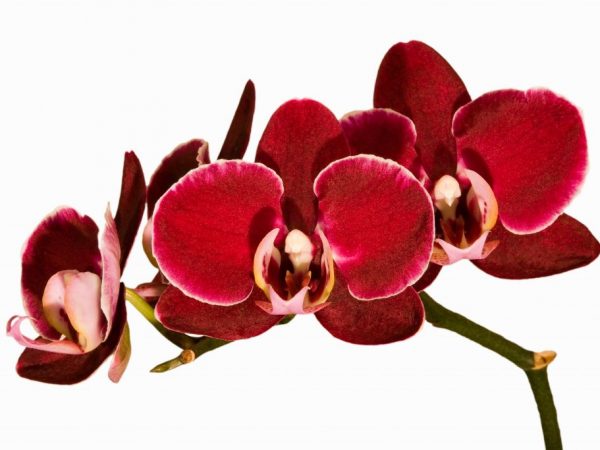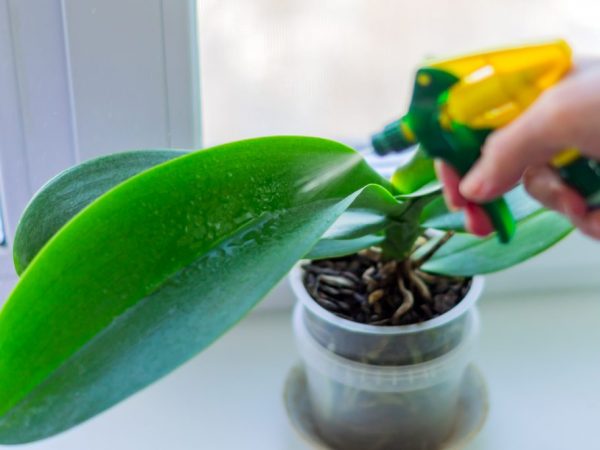Characteristics of the red orchid
There are many types and varieties of orchids with similar characteristics. The red orchid attracts attention with its unusual flowering, but caring for it has a number of features.

Red orchid
Characteristics of the red orchid
The red orchid is a hybrid species. It belongs to epiphytic plants, the vital activity of which is not associated with the soil. In rainforests, these flowers usually grow on tree trunks and get all the nutrients from the environment, but they are not parasites.
The species is unpretentious to the conditions of detention. If you recreate the conditions as in the wild, then the orchid will bloom 2 times a year for 4-5 months. There are cases when the flowering period lasted 8 months.
Description of the stem and leaves
It is a fragile and exquisite monopodial plant. It has a thin and long stem, at the bottom of which 4 to 6 evergreen leaves grow. They are dense and fleshy, deep green in color, although their hue varies from light to dark green.
The leaves age slowly: at first they turn yellow, and then die off, but in their place young leaves immediately grow, which reach up to 50 cm in length and 10 cm in width.
Characteristics of inflorescences and flowers
The number of inflorescences, according to the description of this species, is ambiguous, it changes, depending on the conditions of maintenance and care. When properly maintained, a red orchid can produce up to 40 inflorescences per flowering. One or more flowers appear from one inflorescence. Their total number on one stem varies from 40 to 50 pieces.
Red orchid flowers have a pleasant sweet scent. They have slightly rounded petals, similar to the wings of butterflies. Red orchids come in a variety of shades. The color of the flower varies from delicate scarlet to deep red. The flowers have 3 sepals and 3 petals, the middle of which forms a lip filled with nectar.
Care features
Caring for a red orchid is simple and practically no different from caring for other types of this flower. But there are some nuances, the observance of which allows you to extend the flowering period and improve the growth of the plant. To follow simple rules:
- provide correct lighting;
- maintain the required temperature and humidity;
- properly watered and fertilized the plant;
- the culture is transplanted in a timely manner.
They also monitor the health of the orchid. A healthy plant should have light green roots. If they are brown or dark gray, the flower has a fungal disease or damage to the root system.
Pay attention to the leaves. Healthy leaves are firm, firm and green. Problems are indicated by spots or dark spots on the sheet plate, dents or mechanical damage.
Lighting
Red orchids are light-loving plants. Bright lighting is required for their normal growth. But direct sunlight harms the flower, burning the leaves, therefore, they create diffused light.Depending on the lighting, the leaves are able to change their shape and shade: with a sufficient amount of light, they become light green or have a reddish tint; and in low light they become dark emerald and shrink.
The optimal daylight hours for a plant is 12-15 hours, therefore, in winter, when this period of time is short, additional lighting is created using conventional or fluorescent lamps. The most suitable place for a flower is the east or west side.
Temperature
The optimal temperature regime during the day and at night is different. During the day, the orchid requires at least 20 ° C, but the ideal temperature is 27 ° C. The temperature should not drop below 18 ° C at night. It is important to adhere to such regimes so that the plant grows well and blooms for a long time. The difference between day and night temperatures should be within 5 ° C.
Florists advise keeping the flower in a room with an air temperature of about 16 ° in the autumn period for 1-2 months: this promotes the formation of buds. In the room where the flower is located, air circulation is created. The plant is sensitive to drafts and low temperatures. The fact that he is cold can be judged by the wrinkled lower leaves.
Humidity
Red phalaenopsis prefers high humidity. In hot weather, the plant needs to be sprayed with warm water. Also, the procedure should be carried out in winter when the indoor air is dry due to central heating. You should not spray the plant if the flower is in the sun, as well as during the flowering period, so that water does not get on the flowers. The most suitable time for this is morning or afternoon. Spraying at night is allowed if the flower is in the room, and not on the balcony.
For spraying, you can use pure melt or rainwater. Due to the tap water, a white coating forms on the leaves. Constant humidity is provided in another way - small stones are poured into the flower tray and water is poured, and then a pot with an orchid is placed in it. If the moisture level is sufficient, the roots at the ends will be green.

Spraying a red orchid
Watering
This species is distinguished by the surface structure of the root system. Therefore, the flower receives all the nutrients necessary for life through watering the leaves. For watering, as well as for spraying, you must use warm rain or snow water. When there is no way to get one, it is better to water the plant with boiled, settled water. To avoid decay and death of the orchid, water must not be allowed to enter the growth point.
There is another option for watering - you should lower the flower pot in a bucket of water for 20 minutes. But after this procedure, you should put it in a pan so that excess water is glass. During the period when the orchid has not yet begun to bloom, watering is carried out every 7-10 days. In summer, in hot weather, watering should be done more often - every 2-4 days. If water gets into the leaf axils, be sure to soak it up with a cotton pad.
Fertilizer
It is recommended to apply fertilizers during the period of active growth. You cannot feed the plant immediately after purchasing it, as the orchid takes time to adapt to new living conditions, and this can cause stress. Also, do not fertilize the flower during the dormant period, which begins at the end of flowering.
It is better to use aqueous solutions as mineral fertilizers, rather than fertilizers in the form of tablets, since the tablets are unevenly distributed in the substrate. It is better to buy preparations designed specifically for orchids. You should pay attention to the level of nitrogen in fertilizers, since a large amount of it can harm the plant. Florists recommend applying fertilizers at intervals of 20-25 days and combining this procedure with watering.
Transplant features
A transplant is needed in cases when:
- the flower is not able to resist on its own and constantly turns over;
- root tips appeared on the surface of the substrate;
- a small amount of substrate is introduced;
- the substrate has lost its beneficial properties;
- the lower leaves began to fall;
- most of the roots are spoiled.
Usually, the orchid is transplanted every 2 years, after flowering ends. The pot must be larger than the previous one so that the flower has the opportunity to grow and develop further. The substrate should be well-drained, consisting of tree bark, pebbles, low-lying peat, foam chips, pieces of charcoal.
The most suitable way of transplanting is reloading. For this, the substrate is well moistened so that the roots can easily get rid of it; and then carefully remove the flower from the pot, clean it from the remaining substrate and place it in a new container. The substrate should not be tamped. It is recommended to reduce watering and put the plant in the shade for several days.
Conclusion
The red orchid has a bright and attractive color, thanks to which it fits well into any interior and decorates the house. She is not as whimsical to the conditions of detention as other varieties. In order for the plant to grow well and the flowering period is long, it is provided with proper watering, temperature regime, lighting and feeding.


